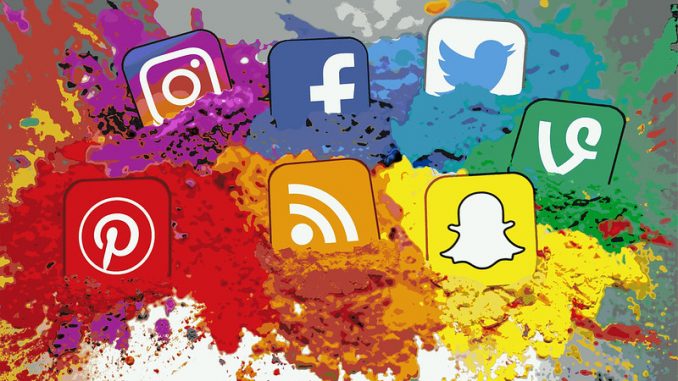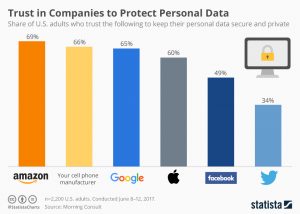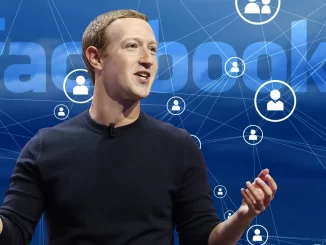
What is A “Techlash”?
With the rapid development of technology, the world has been experiencing a boom of social media platforms for over a decade. After they occupied the human’s life with an incredible speed, there are growing concerns about the “addiction” to digital media and hostility toward the giant tech companies like the ‘FAANG’. This phenomenon has been identified as “Techlash” by Wooldridge (2013) in The Economist and has been gradually spreading globally.
The following part of this blog will take a look at the concerns that lie on the “Techlash” about misinformation, political cyber-attack, mental health issues and ethic. And discuss how the governments, civil society organizations and tech companies address the phenomenon of “Techlash”.
What are the concerns lie on the Techlash?
- Misinformation:
A growing concern is that fake news is driving our “Information Age” to the “Disinformation Age”. According to the survey conducted by Shearer (2021), 86% of American adults get access to news from digital devices and most young adults at the age of 18-29 are more likely to get news on social media platforms. Another study published on the journal Science has shown that fake news is 70% more likely to be shared and spread six times faster than real news on Twitter (BBC, 2018).

Fake news, generally motivated by financial, political or ideological benefits, is a type of misinformation where the information relates to a news event and is intentionally made by people in bad faith (Ackland & Gwynn, 2020). During the Covid-19 pandemic, a large number of fake news has been popping up, here to view a spreadsheet of these misinformation. These kinds of misinformation are now endangering the general public by containing contents like cocaine could protect against the coronavirus. Some of these fake news about Covid-19 was factitiously made and spread for political reasons, which brings another concern which is political cyber-attack.
- Cyber-Attack:
During the pandemic of Covid-19, those conspiracy theories have back in our sight. In the US, “News” surmised that the Chinese government create the coronavirus and in China, the guess of American government created the coronavirus occurs on social media, especially on Zhihu, a Chinese version of Quora. This misinformation has increased racial, gender and other kinds of antagonism to some extent. For example, the violent protests in Hong Kong started in 2019 could be one of the negative consequences driven by misleading content on digital media.
In addition, there is an economic issue that might be considered as one of the factors that raise the number of fake news. The economic benefits of journalism are degrading due to the high costs to produce an accurate original piece of news. However, fake news could be easily monetized by costing much lower because it doesn’t need rigorous research, verification process or trained professionals (Napoli, 2019). In the era of the Internet, an unprecedented opportunity is offered to fake news with the capability to spread content faster and further than ever.
- Mental Health:
Here comes our third concern, the increasing mental health issues with the influence of social media platforms. We will take a look at it from two perspectives, firstly teenagers and young adults and secondly adults as employees in the tech companies.
More and more content on the Internet are making teenagers and youths doubting their self-worth and losing their identity by building up anxiety about their body, appearance, achievement and so on.
A new word recently coined by plastic surgeons is “Snapchat dysmorphia”, to describe the phenomenon of rising numbers of patients that want to look like their filter-added selfies (Chiu, 2018). A report from the American Society of Plastic Surgeons indicated that more than 229,000 teens between the ages of 13 – 19 having cosmetic surgeries in 2017. A typical example of this situation could be the rapidly expanding plastic surgery market in China. A new type of plastic surgery called “Elf Ears” is increasingly sought by frequent social media users. The pursuit of the surgery is to a pointed ear shape, which was lead by a number of Internet influencers in late 2020. This kind of surgery is actually altered the original physiology of the patient, and it was already warned by the experts of a high infection rate. But it still keeps expanding by the lead of social media.
According to Koivusilta (as cited in Augner, C., & Hacker, G. W.,2012), the depression score and daily health complaints were significantly higher for frequent mobile phone users. Also, Statista indicated that the suicide rate in the US among teens and young adults at the age of 15-19 keep increasing since 2007 when the scale of social media become massive.
.jpg)
Not only the youths but adults as employees in the tech companies have also been suffering from psychological issues. In order to content filtering, the jobs as content moderators were created by giant tech companies like Facebook, Instagram and Twitter. More than tens of thousands of workers are asked to detect impropriate content like violence. Not only the high-intensity work is pressuring them, but also the contents they are reading are haunting. For instance, the bloody contents keep flashing back in their mind. They got nowhere to pour out their troubles because of the confidentiality agreement they had signed so they could not access appropriate psychological support without support from the companies.
- Ethical concerns:
To gain profits from the advertisers, tech companies need to predict what the users are interested in. And the prediction comes from a large number of data poured out by users, it brings the concern of privacy and data safety. Furthermore, most of the features on the digital platforms was designed to rise users’ engagement using psychology. For example, we might notice that the function of noticing the users that the other side had already read the message and showing the other side is typing have covered by almost all the social media recently. The role of these features is to keep the users engage in the software and the algorithm will automatically send the advertisements to the users. In this case, awareness of ethical issues among the general public should be raised.
How the concerns could be addressed?
- By the governments:
I believe that governments should take action to monitor tech companies. Joe Toscano, an author of automating humanity, has provided a direction for addressing the concerns in a documentary produce by Netflix. He presented that governments could tax the data collected of the tech companies to create a reason for them not to collect all pieces of the data without limitation. It could be a possible approach, but the most important thing is that it provides a direction that is to get to the root, which is the business model in the market, of the problem. Governments need to pay attention to how to improve the current business model in the industry to address the issues. What’s more, legislation plays a vital part in this situation. The current situation of enforcement action is taken to protect the giant tech companies instead of users, which is not reasonable and need to be changed. A “soft law” and criminal law should be complementary to co-regulate the tech companies, mentioned by Flew (2018). Fortunately, there are some actions taken by the governments to protect the consumers – the European Union enacted the General Data Protection Regulation (GDPR) in 2018 on a large scale (Hemphill, 2019) and ACCC has been considering the enforcement action to regulate the giant tech companies to rectify their monopoly in the industry.
- By civil society organizations:
Civil society organizations, especially those with certain authority and influence, should take the responsibility of raising awareness among the general public about the seriousness of “tech addiction” (Hyperlink). For example, holding events like “Put Down Your Phone for Three Hours” with awards for the winners to draw the attention of the general public.
- By the tech companies:
The self-regulation from the companies themselves could be one of the most essential parts of addressing the techlash phenomenon. The tech companies should take responsibility not only for the contents they delivered, but also the data they collected, the mental health care for the teenagers, their employees and the whole public that might be influenced by them.

According to Statista (2017), most of the users would like to trust the companies with their private data. In addition, ethical concerns need to be paid attention to when they releasing a new technology feature. And also, it might be better for both users and the giant tech companies to prevent monopoly by taking action by the companies themselves instead of enforcement action from the governments, according to Friedman (2019).
Conclusion
Every coin has two sides, the rapid development of technology has always been a two-edged sword. It is nothing wrong that the companies need to be aiming for profit, it is about the current economic environment in the industry. The market would not be changed easily, it might take a long time to get these concerns addressed and there would be another concern popping up, but I believe that the public benefits should always be the most important thing that we working hard to protect.
Further related information:
Take a look at this documentary called “The Social Dilemma” produced by Netflix if you are interested in this topic. It takes about one hour and thirty minutes to finish it, but it does worth sitting down and ignore the social media for a moment to enjoy it.
References
ACCC. (2021). Platforms’ dominance of apps market needs to be addressed. Retrieved from https://www.accc.gov.au/speech/platforms-dominance-of-apps-market-needs-to-be-addressed
Augner, C., & Hacker, G. W. (2012). Associations between problematic mobile phone use and psychological parameters in young adults. International Journal of Public Health, 57(2), 437–441. https://doi.org/10.1007/s00038-011-0234-z
Chiu, A. (2018). Patients are desperate to resemble their doctored selfies. Plastic surgeons alarmed by ‘Snapchat dysmorphia.’. Retrieved from https://www.washingtonpost.com/news/morning-mix/wp/2018/08/06/patients-are-desperate-to-resemble-their-doctored-selfies-plastic-surgeons-alarmed-by-snapchat-dysmorphia/
Dinah L. Shelton (2008), Soft Law in HANDBOOK OF INTERNATIONAL LAW, Routledge Press. Retrieved from https://scholarship.law.gwu.edu/cgi/viewcontent.cgi?article=2048&context=faculty_publications
Elflein, J. (2019). Suicide and homicide rate among U.S. teens aged 15 to19 from 2000 to 2017. Retrieved from https://www.statista.com/statistics/1063003/annual-suicide-and-homicide-rate-in-the-us-for-persons-aged-15-to-19/
Elizabeth Dwoskin, J. W., Regine Cabato (2019). Content moderators at YouTube, Facebook and Twitter see the worst of the web — and suffer silently. Retrieved from https://www.washingtonpost.com/technology/2019/07/25/social-media-companies-are-outsourcing-their-dirty-work-philippines-generation-workers-is-paying-price/
Flew, T., 2018, ‘Platforms on Trial ‘, Intermedia 46(2), pp. 24-29.
Friedman, J. (2019). This is why a self-regulated Google is better for business and for the consumer. Retrieved from https://www.businessinsider.com/self-regulated-google-better-for-business-and-for-the-consumer-2019-3
Hemphill, T. A. (2019). ‘Techlash’, responsible innovation, and the self-regulatory organization. Journal of Responsible Innovation, 6(2), 240-247. doi:10.1080/23299460.2019.1602817
Kleinman, Z. (2018). Fake news ‘travels faster’, study finds. Published by BBC News. Retrieved from https://www.bbc.com/news/technology-43344256
Napoli, P. (2019). Social Media and the Public Interest: Media Regulation in the Disinformation Age. New York Chichester, West Sussex: Columbia University Press. https://doi-org.ezproxy.library.sydney.edu.au/10.7312/napo18454
Robert Ackland, K. G. (2020). Truth and the Dynamics of News Diffusion on Twitter. In M. E. J. Rainer Greifeneder, Eryn J. Newman, Norbert Schwarz (Ed.), The Psychology of Fake News (1st Edition ed., Vol. 20, pp. 27-46). London. “Big Tech Companies” by Huzaifa Abedeen, CC BY-SA 4.0 https://creativecommons.org/licenses/by-sa/4.0
SHEARER, E. (2021). More than eight-in-ten Americans get news from digital devices. Retrieved from https://www.pewresearch.org/fact-tank/2021/01/12/more-than-eight-in-ten-americans-get-news-from-digital-devices/
Wooldridge, A. (2013). The coming tech-lash. Retrieved from The coming tech-lash | The Economist
Zuo, M. (2021). China’s ‘elf ear’ cosmetic surgery increasingly sought by young people seeking a thinner, slimmer face. Retrieved from https://www.scmp.com/news/people-culture/social-welfare/article/3136795/chinas-elf-ear-cosmetic-surgery-increasingly

This work is licensed under a Creative Commons Attribution-NonCommercial 4.0 International License.

